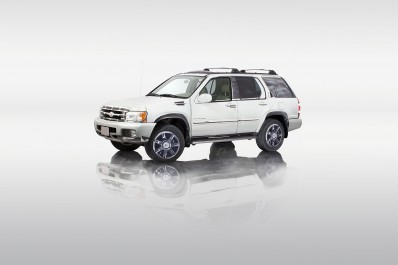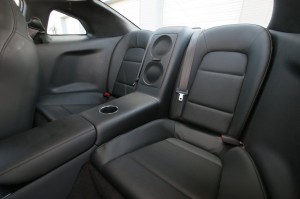Backseat
October 1st, 2013
Chrisy MacLear interviews artist Jonathan Paul Gillette for the October 2013 edition of the Artist of the Month Club.
note: this conversation/interview took place in backseat of jonathan paul gillette’s 2002 nissan pathifinder cadillac, as Christy MacLear (the interviewer) and Jonathan Paul Gillette were driven around the city.
Christy MacLear:
So we’re here in your “nissan cadillac” and I want to talk to you about your work, first, and second the more philosophical position about the ideas of consumption, identity, envy and aspiration to name a few. So Jonathan, tell me first about this photograph:
Jonathan Paul Gillette:

The photograph is of my everyday automobile, a 2002 nissan pathfinder. i took photos of a 2012 Cadillac escalade, set them up as a car wrap and hired a local signage business to apply the wrap to my automobile. for the past 2 years, my former automobile has been concealed, covered by images of a 2012 Cadillac escalade. my former automobile is now neither a Cadillac escalade nor a nissan pathfinder. it appears to be a Cadillac that swallowed a pathfinder or a pathfinder wearing the skin of an escalade – not fully either, but tethered to both, it negotiates the inevitable compromises that go along with performing an identity.
As a photograph, its function is similar to a high school fantasy poster: aspiration images of Ferraris, Lamborghinis, Porsches that aided in propelling the identity crisis of adolescence, fantasies always seen alone with their reflection in a black void.
The vehicle was photographed in a psyche room, left to reflect its own moratorium.
Unlike an imitation Louis Vuitton bag, which is fixated in a symbolic role, my vehicle seeks the real. it is attempting to inhabit something other than itself without changing.
As my reliable mode of transportation, it suffers an identity crisis, a crisis which it assumes as a role in the midst of others seeking their own roles of viewership
For example, the other day i found my tire flat. after rolling up on a spare, i sat and watched employees take photos and pose beside my automobile. as i went outside to retrieve my automobile, an employee drove it up and upon getting out threw me the keys. in a muffled, proper voice he said, “your escalade, Mr. Gillette.”
I love how he chose to participate in the theater of it, a theater rooted in Edward Bernays.

On another occasion, i was pulled over for running a stop sign. the officer remained in the patrol car for over 15 minutes. finally, the officer approached very cautiously, asked for my license, registration and insurance, and then offered a suggestion: “if i were you, i would remain calm and whatever you do, do not get out of the car.” she returned to the patrol car and, after another 20 or so minutes approached the front of my automobile, squinted at the hood, and walked around the other side, touching it and picking at the image, even stopping to look underneath the vehicle. returning to my window the officer asked:
“what kind of vehicle is this? you will have to remove the wrap as you are impersonating another vehicle. i’m not sure what law you are breaking, but…..you are breaking some law.”
CM:
With that explanation – I wanted to challenge you by asking: Isn’t a cadillac not just a car but a hypothetical level of luxury – yet funnily not on that level of luxury itself? Meaning the term “its the cadillac of the xx…or yy” but yet our contemporary culture doesn’t really value cadillacs as the best car itself. What do you make of that?
JPG:
I appreciate what you’re pointing out here and am tempted to simply agree – it is certainly a hypothetical level of luxury, but the question is: for whom is it hypothetical, and for whom isn’t it hypothetical? that is what i do not know, and, further, i do not know how to begin to assess what level defines luxury.
Perhaps it is possible to ask here: in order to have a hypothetical level of luxury, to prove the hypothesis, must someone believe? and then, if this is the test, is it a what or a who that is to be tested? in other words, where, or at what level does this hypothesis lie?
Certainly the manner in which the Cadillac is set in relation to other lines in the GM family, demonstrates that, in a way, you are correct. it is a construct for attenable luxury.
Perhaps the attainable thing lies in the experience – which becomes difficult to see if only at the level of wondering what lies inside, and what remains outside the experience. further, can the supposed real space be found in either distinction – inside, outside? is it, perhaps, in between? there is the inside and outside of the disguised automobile, of course, but this is only an envelope.
 My great grandmother believed that Perry Mason was a real lawyer. she would tell others about his methods and brag about watching him win in court. “that Perry Mason,” she would say, “he never lost a case.”
My great grandmother believed that Perry Mason was a real lawyer. she would tell others about his methods and brag about watching him win in court. “that Perry Mason,” she would say, “he never lost a case.”
And what i think about is:
Which experience is the more real, hers or mine? the fact is that Perry Mason is a show or an image that i myself constitute in an imaginary dimension. i can never have the supposed real experience that she is privy to. is it possible for me to be in my great grandmother’s position without having to fabricate a construct in the attempt? i often think about how i am the one that is fooled and not privy to the facts of the matter.
CM:
Jonathan I think of your work as linking identity to the timely topic of appropriation. You had another work which converted blue light special shoes into air jordans. Tell me about the root of this work.
JPG:
As for the piece you mention, nikes: kmart purchased the brand British Knights, and shifted its style by interpreting older styles from Nike. i purchased a pair from kmart and made them appear to be Nikes with materials i found around my apartment.
A classmate of mine in high school took a kmart backpack and with white-out, painted a swoosh over the other brand emblem. from a couple feet away it posed as the real thing. close up, you could see the cracking in the white-out.
I remember people talking about this from a distance, but no one conversing with the student about the gesture. it had a profound impact on me, though. when something acts inauthentically, it demands attention in illuminating the feeling that there is a deficit.
What was his motivation? was he interested in: the design, the status, the ownership, the act of changing, the act of defacing, the act of mark-making, or simply fitting in?
His backpack is beyond what it tried to fit in with insofar as it easily could be seen as: the newest, rare, foreign, special, limited.
What was his investment and who was his investment for? and basically, who is at the helm of his ego ideal?
Is it a failure?
What is the outcome for all participants of an appropriation? what makes the appropriation a success or a failure?
CM:
I have known you for nay 15 years now I think – right Jonathan? Well I know you are a deeply religious person, very close to your family and have taken a different path of teaching and thinking. Correct? Tell me where this has taken you and why the cadillac piece is important as a part of your journey.
JPG:
The 2002 nissan pathfinder escalade, which is neither an escalade nor a pathfinder, but more of a frontier, occupying a kind of border space, mirrors my relationship to the question you ask. all answers seem to run contrary to the truth and as i begin to respond, i feel i betray everyone involved in my life. i feel all stances i might take in responding will be inadequate. there is no perceivable satisfactory posture to assume. for me the question lacks an identity.
CM:
Jonathan, I want to welcome you to New York. I’m not sure the world is ready for what you have to unleash for us. We’re all here to learn and we have you to guide us. So I’m proud of you and your journey.